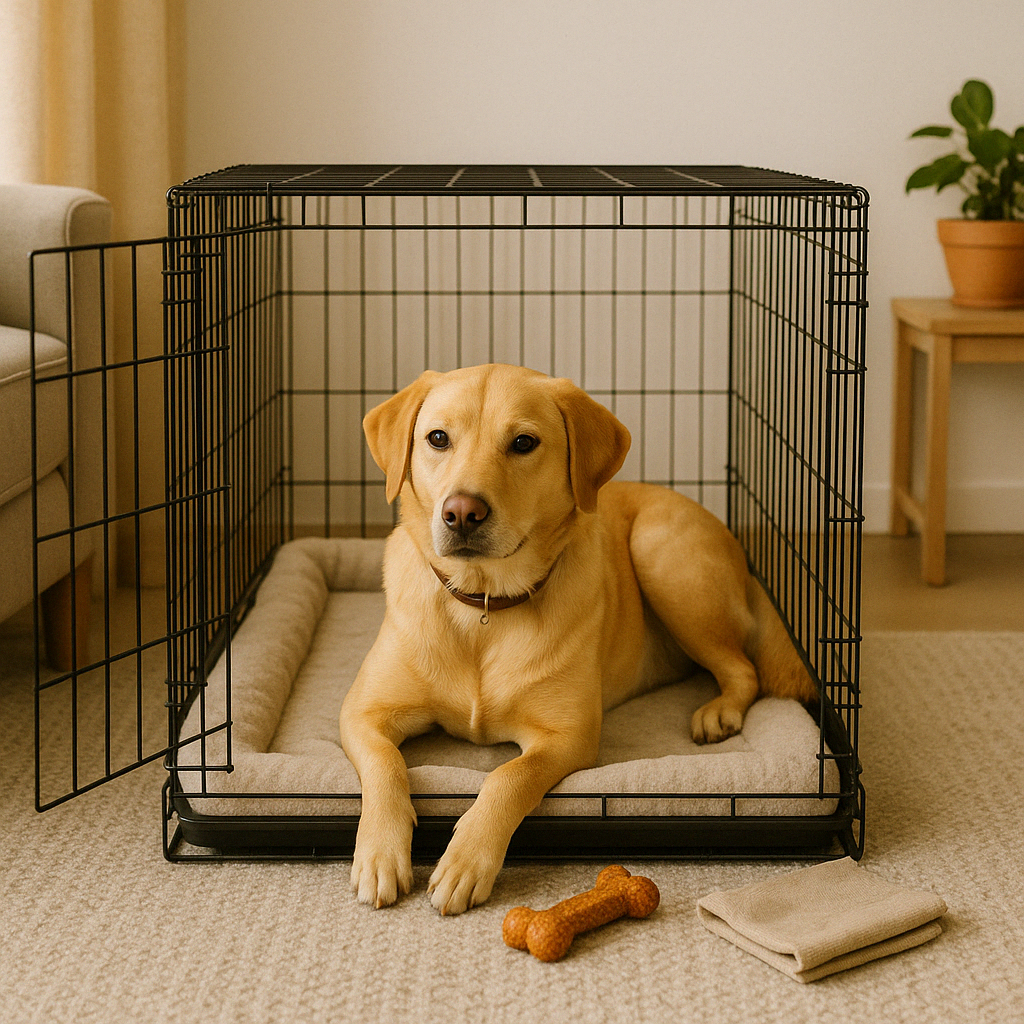Crate training is one of the most valuable tools in a dog owner’s toolkit. When done properly, a crate becomes a secure and positive space for your dog — not a punishment. It helps with housebreaking, routine, travel safety, and giving your dog a place to relax.
In this article, you’ll learn how to crate train your dog in a calm, respectful way that promotes trust and independence.
What Is Crate Training?
Crate training involves teaching your dog to view a crate as a safe, comfortable den — a place to sleep, relax, and recharge.
A crate can be used for:
- House training
- Creating a safe space when unsupervised
- Preventing destructive behavior
- Travel and vet visits
- Recovery after surgery
Crates should never be used for punishment or excessive confinement.
Choosing the Right Crate
Crates come in various styles:
- Wire crates – Good ventilation, foldable, visible surroundings
- Plastic travel crates – More enclosed, good for shy dogs or travel
- Soft-sided crates – Lightweight, not ideal for chewers
- Furniture-style crates – Blend into decor but are heavier
Sizing is critical:
- Your dog should be able to stand, turn around, and lie down comfortably
- Use dividers for puppies to prevent accidents in large crates
Too small = uncomfortable. Too big = may invite potty accidents.
Where to Place the Crate
Ideal crate locations:
- In a quiet, low-traffic area of the home
- Near where the family spends time (dogs are social)
- Away from direct sunlight, drafts, or loud noise
Avoid isolating your dog in a basement, garage, or far-off room.
Step-by-Step Guide to Crate Training
Step 1: Make the Crate Inviting
- Line it with soft bedding or a crate pad
- Add a safe chew toy or stuffed KONG
- Leave the door open at first
Let your dog explore it on their own — no pressure.
Step 2: Associate the Crate with Good Things
- Toss treats or meals inside the crate
- Feed meals just inside the door, then deeper inside over time
- Praise calmly when they enter the crate
Build positive associations slowly and gently.
Step 3: Close the Door for Short Periods
- Start with a few seconds, then gradually increase
- Stay nearby and speak softly
- Open the door before your dog shows stress
Repeat until they’re calm with longer closed-door sessions.
Step 4: Practice Leaving the Room
- Once they’re calm in the closed crate, begin stepping away
- Return quickly at first, then extend time
- Keep departures and returns calm and low-energy
This helps prevent separation anxiety and builds independence.
How Long Can a Dog Stay in a Crate?
General guidelines:
- Puppies under 6 months: 1 hour per month of age (max 4 hours)
- Adults: 4–6 hours max during the day
- Overnight: 6–8 hours (with breaks for younger dogs)
Never use the crate as long-term storage for your dog. It’s a tool, not a prison.
Common Crate Training Mistakes
- Using the crate as punishment
- Forcing the dog inside
- Leaving them crated for too long
- Not gradually introducing it
- Ignoring signs of distress
Patience is key — every dog adjusts at their own pace.
Crate Training for Puppies vs. Adult Dogs
Puppies: Crates help with potty training, chewing control, and establishing routine. They adapt quickly but require more frequent breaks.
Adult dogs: May need more time to adjust, especially if they’ve had negative crate experiences. Use more encouragement, calm repetition, and slow exposure.
When to Avoid Using a Crate
Avoid crating if:
- Your dog has severe separation anxiety (consult a trainer)
- They panic, howl, or injure themselves inside
- They soil the crate repeatedly (may need vet evaluation or retraining)
In these cases, crate training should be guided by a professional.
Final Thoughts
Crate training, when done with care and patience, gives your dog a personal safe zone — a place they can retreat to, rest in, and feel secure. It helps with structure, safety, and trust.
Treat the crate as a tool of respect, not restriction. When your dog sees their crate as a den, you’ve built something valuable — a foundation of peace and confidence for both of you.

